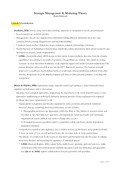Strategic Management & Marketing Theory
Exam Summary
Lecture 1: Introduction
- (Suddaby, 2010): construct clarity, how to define something, implications on management in real life, operationalization
- Good concepts are useful for practice
- Management concerns can originate from individuals holding different definitions about the same
concepts, thereby causing disagreements and misunderstandings
- Construct clarity involves: definitions, scope conditions, semantic relationships, coherence
- Needed because of: facilitating communication, empirically explore phenomena, allow greater creativity and
innovation in research, avoids fragmentation
- LINK: (Arend & Bromiley, 2009) discuss in their article 4 major problems that arise from the dynamic
capabilities view, making it not usable for practice. The problems are: unclear value added to existing
concepts, no clear theoretical foundation, weak empirical support and unclear practical implications. The
authors therefore advise the field to not use the DCV framework anymore. The framework would
improve if it would have clearly defined terms, it would make relevant predictions different from other
theories, being based on good empirical support and when it offers practical guidance, in dealing with
competition.
- (Baum & Shipilov, 2006) organizational ecology, competition needed to gain legitimacy, n shaped relationship between
competitors and performance, links to other entrants
- Illustrates how ecological approaches, emphasizing the importance of the environmental causes (vs trait
approaches emphasizing an individual’s distinctive features) provide a better explanation for empirical
problems that causes organizations to fail
- Organization’s competition and diversity explained by social, economic and political conditions
- Processes that say something about the performance of new entrants
- 1) Demographic processes: age dependence (older less likely to fail), liability of newness (when new
less likely to fail, then high, later again low), size dependence (small org trouble with recruiting),
organizational inertia (difficult and costly to change who you are)
- 2) Ecological processes: specialists (niche) vs generalists (whole spectrum), density dependence,
population dynamics,
- Competition is needed to gain legitimacy, due to relation between performance and population density,
if there are more of you you will perform better, but too many leads to worse performance.
- The density of a market can be the source of innovation and dynamism but also the cause of making
know-how obsolete and decreasing the legitimacy of individual players.
- LINK: (Baum & Shipilov, 2006) explain Niche-width theory: specialists perform better in a stable
environment while with environmental variability specialists could face difficulties, and generalists
less. (Jia et al., 2022) explains collaborations between generalists and specialists.
Pagina 1 van 15
, - (Kennedy, 2008) press releases and effect on performance, mentioning competitors, media coverage
- Early entrants benefit from inviting coverage that makes a few links to other entrants, as it helps audiences
perceive an emerging category -> serves as a prototype
- When market matures, linkages to rivals does not work in your advantage, the relationship is n-shaped.
Mentioning some competitors is good, too many is bad.
- Test market was computer workstations, media coverage (news stories and press releases) on new entrants
was gathered
- Cognitive embedding (together with social network analysis) also effects prominence or position in an
emerging market category, it enhances the sense making process of individuals
- Reality is shaped by social belief
- (Kuijken et al., 2016) value to product service system, servitization paradox
- How consumer perceptions on the added value highly effects the performance of a firms PSS, creating
value by adding a PSS.
- Servitization: offer services that supplement traditional products.
- Servitization paradox: adding servitization does not increase performance as firms struggles with
integrating the new service (radically new solution) while the culture of the organization still is focused on
the traditional product, due to the fact that knowledge on how to effectively develop, manage, and market
PSS is still emerging.
- LINK: (Baum & Shipilov, 2006) Organizational inertia, difficult and costly to change who you are.
- The product and service elements of the PSS should have autonomous value to be sold separately on the
market
- Product and service should come from different quadrants of the 2 × 2 matrix (tangibility, and importance
of interaction between producer and consumer)
- The combination of product and service elements should create synergy, be worth more than the sum of
its parts.
- Tangible characteristics more important for products, while interaction moments more important for
services
- LINK: (Mol & Wijnberg, 2005) The servitization is a strategic move that can happen after the Value
Chain Envy has come into existence.
Lecture 2: Network or Organization
- (Simon, 1991): combines transaction theory by Coase’s and Williamson reasoning on why firms exist, organization
- Highlights that a market and an organization can be distinguished by looking at organizational efficiency
and not the failure of the market (from Wijnberg, 2004)
- Coase: Why do firms exists? In his paper nature of the firm, firms can reduce transaction costs (in
comparison to the market) (not mentioned in paper)
Pagina 2 van 15




